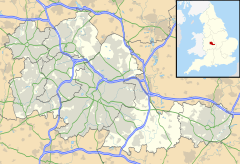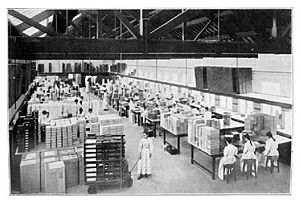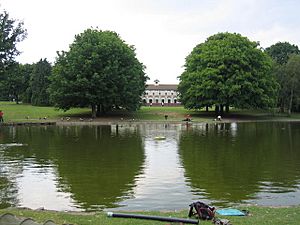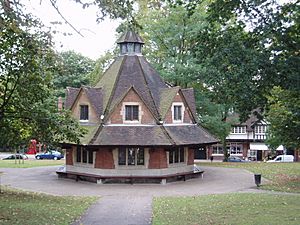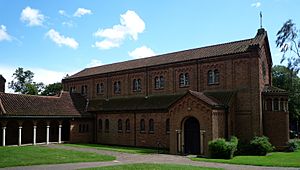Bournville facts for kids
Quick facts for kids Bournville |
|
|---|---|
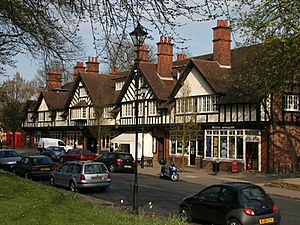 The shops around The Green |
|
| Population | 25,938 (2011.ward) |
| Metropolitan borough | |
| Metropolitan county | |
| Region | |
| Country | England |
| Sovereign state | United Kingdom |
| Post town | BIRMINGHAM |
| Postcode district | B30 |
| Dialling code | 0121 |
| Police | West Midlands |
| Fire | West Midlands |
| Ambulance | West Midlands |
| EU Parliament | West Midlands |
| UK Parliament |
|
Bournville (/ˈbɔːrnvɪl/) is a special 'model village' located in Birmingham, England. It was created by the Quaker Cadbury family for the people who worked at their famous Cadbury's chocolate factory. The idea was to build a "garden village" where people could live in a healthy and happy environment. A unique rule in Bournville is that alcohol has never been allowed to be sold there.
Cadbury's is well known for its delicious chocolate products, including a dark chocolate bar called Bournville. This area is considered one of the best places to live in the UK. In fact, a study in 2003 called it "one of the nicest places to live in Britain." Bournville is also home to the Bournville Centre for Visual Arts and the Cadbury's chocolate factory.
Contents
How Bournville Began
Before Bournville was built, this area was mostly open countryside with a few farms and small houses. There was a large house called Bournbrook Hall, built a long time ago. People also found old Roman remains nearby, showing that people lived here even in ancient times.
The Cadbury Family's Vision
In 1861, brothers George and Richard Cadbury took over their father John Cadbury's growing chocolate business. They needed a bigger factory than their old one in central Birmingham. They wanted a new place that was clean, healthy, and had room to grow.
They found the perfect spot about 4 miles (6.4 km) south of Birmingham. This location was great because it had access to both canals (for milk) and railways (for cocoa beans from ports). In 1879, they moved their factory to Bournbrook Hall. It was a rural area but already had a railway station nearby.
The Cadburys named the area 'Bournville' after a local river called The Bourn. They added 'ville,' which is French for 'town,' to make it sound special. The Cadburys were very fair to their workers. They paid good wages, offered good working conditions, and were pioneers in offering pension plans and medical services.
Building a Model Village
In 1893, George Cadbury bought 120 acres (0.5 square kilometers) of land near the factory. He wanted to build a 'model village' to help people escape crowded city living. By 1900, there were 313 homes on 330 acres (1.3 square kilometers) of land. Many more houses were built later.
These homes were designed by architect William Alexander Harvey. They looked traditional but had big gardens and modern insides. These designs became a guide for other model villages across Britain. Because George Cadbury was a Quaker and believed in temperance, no pubs (places selling alcohol) were ever built in Bournville.
The Cadburys cared a lot about their workers' health. They included parks and recreation areas in Bournville. They encouraged sports like swimming, walking, and football. In the 1920s, they bought more land at Rowheath for sports fields, bowling greens, a fishing lake, and an outdoor swimming pool.
The Rowheath Pavilion, opened in 1924, served as a clubhouse for these sports areas. All these facilities were free for Cadbury employees and their families. The outdoor pool closed in the 1970s. Cadbury's also built indoor swimming baths and a beautiful cricket pitch near the factory.
In 1900, the Bournville Village Trust was created. This group manages the Bournville estate independently from the Cadbury company. Elizabeth Cadbury became the head of the Trust in 1922 after her husband. The Trust focused on providing schools, hospitals, museums, and reading rooms.
Today, Bournville is a conservation area, which means the Trust also approves plans for building changes. The village has a central green, schools, an art school, and a Quaker meeting house. The Trust still helps with housing and town planning ideas worldwide. Bournville now has 7,800 homes and lots of parks, making it a popular place to live.
Cadbury is still a major employer in Birmingham and continues to make chocolate. The dark chocolate Bournville bar is now made in France. Cadbury also named their malted drink, Bournvita, after Bournville. You can also visit Cadbury World here!
Local Government
Bournville is part of the Bournville & Cotteridge ward. This area is represented by two local councillors, Liz Clements and Fred Grindrod, both from the Labour Party. It is also part of the Birmingham Selly Oak area for the UK Parliament. The current Member of Parliament is Alistair Carns.
People of Bournville
The 2011 UK Census showed that 21,866 people lived in Bournville. The area has a population density of 4,217 people per square kilometer. About 52.9% of the people living here are female. Some students from The University of Birmingham also live in Bournville.
Most of the people in Bournville (70.9%) are from a White ethnic background. The next largest group (15.4%) is Asian. More specifically, 64.1% of residents are White British. About 28.7% of the people in Bournville were born outside the UK. Christianity is the main religion, with 70.6% of people identifying as Christian. About 16.6% said they had no religion.
Most residents (98.3%) live in households. The average household has 2.3 people. Many homes (62.5%) are owned by the people living in them. Terraced houses are the most common type of home (38.9%), followed by semi-detached houses (32.9%).
The largest age group in Bournville is 25–44 years old (30.1%). About 60.7% of the population is of working age. The unemployment rate is 6.2%, which is lower than the average for Birmingham. The biggest employer in the area is Mondelez International, which owns Cadbury, employing about 6,500 people.
While Bournville is famous for its older Cadbury-style homes, there are also many newer houses. Some were built by the local council, and others by private builders in the 1970s.
Learning in Bournville
Elizabeth Cadbury was very interested in education and helping young people in Bournville. There are several primary schools in the area, including Bournville Junior School, Bournville Infant School, and St Francis Primary School. St Francis Primary School opened in 1979 and has 243 children.
Dame Elizabeth Cadbury School is a secondary school and sixth form named after Dame Elizabeth Cadbury. It opened in 1955. Bournville School is another secondary and primary school for students aged 4–16.
Bournville also has Bournville College of Further Education. This college moved to a new campus in Longbridge in 2011. The Bournville Centre for Visual Arts is part of Birmingham City University. It offers different art courses for students.
Getting Around Bournville
Bournville is located on the A4040 ring road. You can catch the 11A and 11C Birmingham Outer Circle bus routes here. Other bus services like the 27 and 84 also serve the area.
To get to Birmingham City Centre, you can use the Bristol Road (A38) or the Pershore Road (A441). Several bus routes, like the X61, 63, 98, 144, 45, and 47, travel on these roads.
Bournville has its own train station, Bournville railway station, on the Cross-City Line. This line connects to Birmingham New Street, Lichfield, and Redditch. The Bournville station is painted in Cadbury's purple color, unlike other stations in the area.
The National Cycle Network route five passes near Bournville, leading towards Hurst Street in the City Centre. You can also cycle along the Worcester and Birmingham Canal towpath to Brindleyplace.
Places of Worship
Bournville has several Christian churches. These include St Francis of Assisi Church, which is a Church of England parish church. There is also a church dedicated to Saint Andrew and Oak Tree Church, which is a joint Church of England and Methodist venture. Rowheath Pavilion Church meets in Rowheath Pavilion. Riverside Church also meets at Dame Elizabeth Cadbury School.
There is a special Serbian Orthodox Church called St. Lazar, or Lazarica, on Cob Lane. It is built in the traditional Byzantine style, similar to famous churches in the Balkans. The inside is decorated with beautiful wall-paintings.
Since Bournville was founded by Quakers, a meeting house was built for them. The Bournville Friends Meeting House on Linden Road was built in 1905. It has an organ, which is unusual for a Quaker meeting house in Britain. As part of the Quaker tradition, Bournville is a "dry town," meaning no alcohol is allowed to be sold within its original boundaries.
Famous People from Bournville
- Bertha Bracey, a Quaker aid worker
- James Jaysen Bryhan, an actor
- John Cadbury, who started Cadbury's chocolate
- Nigel Dakin CMG, a soldier and diplomat
- William Alexander Harvey, an architect
- Natalie Haynes, an author and comedian
- Felicity Jones, an actress
- Julia Varley, a suffragette and trade unionist
- Clive Wedderburn, an actor
Images for kids


